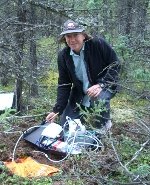The significance of land surfaces for the climate-relevant carbon cycle.
Susan Trumbore, Managing Director at the Max Planck Institute for Biogeochemistry in Jena, researches material cycles and their role in climate development. At the renowned “Sackler Colloquium” of the American National Academy of Sciences on April 1, 2011, the geoscientist will give a lecture on the past and future role of the land surface and its ecosystems in the global climate balance.

Susan Trumbore, Professor of Earth System Research at the University of California, Irvine (USA), has been Managing Director of the Max Planck Institute for Biogeochemistry since September 2010. In addition to several awards and an honorary doctorate from Hasselt University (Belgium), Trumbore was elected a member of the American National Academy of Sciences at the end of 2010. This honorary society, founded in 1863, consists of the world's leading scientists from various disciplines. In conjunction with her appointment, Susan Trumbore will speak on April 1, 2011 in Washington (DC) as a guest of the Academy's annual “Sackler Colloquium” on the past and future role of the land surface and its ecosystems in the global climate balance. In the keynote lecture, Steven Chu, US Secretary of Energy, will speak about the challenges of climate and energy change.
Trumbore, Max Planck Director since 2009, is researching the climate-relevant carbon cycle in particular with her department in Jena. “We are currently concentrating on three areas that have so far been very poorly characterized and are particularly sensitive to climatic changes or anthropogenic influences,” says the trained geologist.
One area is concerned with the question of whether soils are a source or sink for carbon. “We therefore want to analyse key processes and better characterize the 'soil organism as a whole' in terms of its significance for material cycles,” explains Trumbore. The second area is dedicated to carbon, which is absorbed photosynthetically by plants as atmospheric carbon dioxide (CO2) and bound as sugar. Trumbore is investigating the distribution of these carbon-containing molecules in the plant, their various functions in growth, stress defense and energy storage, as well as the release of carbon back into the atmosphere through respiration, leaf fall and plant death. In the third area, Trumbore's department is investigating whether and how biodiversity can influence the carbon cycle: “Initial results show that a high level of biodiversity is associated with lower emissions of climate-damaging CO2”.
In order to answer the complex research questions, suitable field experiments and measurements are carried out in addition to laboratory experiments. The Jena Institute's field stations include measuring towers in the Siberian tundra, on the Cape Verde Islands, in Namibia and in the Brazilian rainforest, in the Fichtelgebirge mountains and in the Hainich Nature Park in Thuringia, as well as other measuring stations on the Shetland Islands and in Canada. The data from local measurements are compared at the MPI-BGC with supra-regional and global data sets using mathematical modeling and the findings are integrated into global and regional climate concepts.
